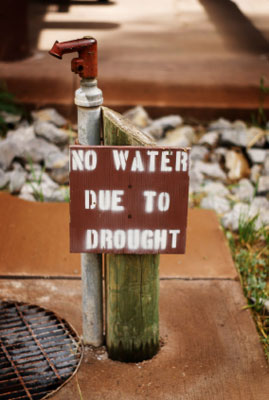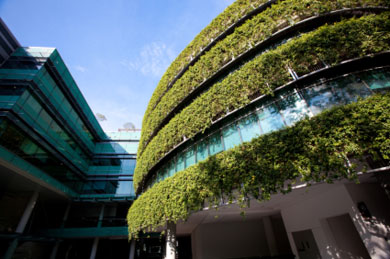21st Century Cities Why Greening Matters
We could barely see the grass – a small island of green amid a sea of concrete rooftop at the Interior Department’s Washington, D.C. headquarters. But, for the Nation’s premier conservation agency, it was a poignant signal that cities and city structures, by “going green,” can be a part of the conservation equation.
Each year, more than a billion gallons of raw sewage flow into the waterways of the Nation’s capital. Stormwater races across rooftops and pavement, as it picks up oil residues, other contaminants and detritus. Old infrastructure, overloaded during big storm events, overflows and spews this urban brew into Rock Creek and the mighty Potomac River. But this story is changing in cities across America – and the Interior Department’s patch of green rooftop is part of that saga.
Green roofs, like the one we unveiled at Interior in 2008, can absorb rainwater, thus reducing stormwater runoff. There are other benefits as well. Green roofs shield buildings from direct sunlight, save energy and improve air quality by filtering air as it moves across plants. But green roofs are just part of a “greening” picture that has begun to reshape urban landscapes. Seventy years after Los Angeles began paving its river into 52 miles of concrete corridor, the city is now chipping away at that concrete. Philadelphia is converting pavement to permeable landscapes. Many cities are planting trees and creating natural landscape corridors.
This 21st century, cities are changing. They are restoring nature and its functions to the metropolis. Natural landscapes purify water and absorb pollutants from the air. They help regulate climate, thus maintaining cooler temperatures through shading. They help protect coastal communities from catastrophic storms and prevent erosion. Urban greening is not new. But, it is gaining momentum in response to several challenges:
-

© iStockphoto.com/amygdala_imagery
First is aging infrastructure. Many water and stormwater systems are more than 100 years old with exorbitant replacement costs. Washington, D.C., alone is building new tunnels to handle sewer overflows at a cost of $2.2 billion.
- A second challenge is poor performance of existing infrastructure – consider flood control infrastructure in New Orleans.
- Third is the emergence of challenges associated with a changing climate – more frequent extreme storm events, reduced water availability in some places, more incidents of 100 degree summer days. Chicago city managers, for example, drawing on climate models, estimate the number of days over 100° F in Chicago could increase from the current two days per year to as many as 31 days per year. These changes strain current infrastructure and resource management.
- Finally, budget constraints – both operating budgets and challenges of maintaining and replacing infrastructure – are pushing cities to examine new ways to meet urban needs.
But, can urban greening make a difference? Old-fashioned impermeable surfacing contributes to stormwater runoff. A Heinz Center 2008 State of the Nation’s Ecosystems Report states that “nearly 60 percent of urban and suburban landscapes in the nation had more than 30 percent impervious surface cover, a level at which adverse impacts on stream ecosystems have been observed.”
And, reliance on gray infrastructure contributes to water consumption challenges. Urbanization and land transformation result in reduced water infiltration into the soil and increased runoff to surface water. Loss of tree canopy contributes to rising temperatures in urban areas. Bringing nature back into cities can help reverse these trends. The U.S. Forest Service studies of “urban forests” show notable linkages between tree canopy and urban temperatures. One study in Minneapolis estimated annual savings of $6.8 million in energy costs resulting from existing tree canopy. In Atlanta, planting of shade trees reduces cooling costs by 34 percent in some locations.
More forest cover in watersheds also reduces water treatment costs. A study of 27 water suppliers concluded that each 10 percent increase in forest cover in a water source area decreased treatment and chemical costs by 20 percent. Restoring permeable surfacing and expanding tree canopy in cities can reduce stormwater runoff and associated contaminants from entering urban streams. With some climate models projecting increased frequency of high-intensity rainfall events, reducing stormwater becomes increasingly salient to cities.
Using nature as its guide, Portland, Oregon achieved a 95 percent stormwater flow reduction by using plants, microbes and soils to reduce flows and to remove pollutants from stormwater runoff. Seattle reduced the volume of run-off in one neighborhood by 98 percent by using green infrastructure, and the price tag was 25 percent less than traditional tools. These examples highlight the services natural systems and their components provide to human communities, their health, safety and prosperity. Many U.S. cities are pushing the greening envelope. But, expanding these efforts may require new governing tools and innovative use of existing tools.
Several factors contribute to difficulties in urban integration of greening efforts. Agency “silos” inhibit coordination across air, water, wastewater, stormwater, climate, energy, open space and other infrastructure and services. In Albany, New York, for example, the city owns the wastewater plants but does not own the piping leading to the plants. This ownership segregation inhibits opportunities to rethink wastewater infrastructure and to use wastewater fee revenue to revise pipe infrastructure.
At the state level, similarly fractured responsibilities are common. In the State of Virginia, for example, the Department of Environmental Quality permits wastewater while the Department of Conservation and Recreation handles stormwater permits. Federal and state permitting structures that segregate planning and actions into discrete activities and issue areas make integrated ecosystem planning difficult. Coordinating across jurisdictional boundaries may present the single biggest 21st century governance challenge.
But incentives and pricing matter, too. Fees that provide incentives to establish, to protect or to enhance natural ecosystems and green infrastructure can motivate “green” investments. Three decades ago, the City of Bellevue, Washington established a stormwater utility and inaugurated the first-ever stormwater utility fee.

© iStockphoto.com/Entienou
The city’s stormwater fees are pegged to amount of impervious surface and total surface area. The fees are a catalyst for conservation that reduces the quantity of stormwater runoff and brings water quality benefits. The fee structure, by creating incentives for greening that reduces stormwater flows, reduces the need for expensive additional stormwater management facilities.
Within the past two decades, the services of natural systems, their components and their functions have slowly become a focus of environmental science and policy discourse. After three decades of academic inquiry, cities are turning ideas into action.
The 20th century was a time of immense and rapid urbanization. Vast networks of infrastructure were built to provide communities with water, wastewater, waste management, and transportation systems, flood protection and other services. Accompanying these services, agencies – Federal, state and local – proliferated, thus fulfilling specialized and compartmentalized purposes. Through this infrastructure and these agencies, many benefits were brought to communities. But, changing circumstances are outstripping the capacities of both infrastructure and governing structures. Cumulative negative impacts of this infrastructure and its transformation of ecosystems point to the need to rethink the nexus of city and countryside, people and places, ecosystems and economies. With their urban greening efforts, cities are setting the foundations for this new future.




























